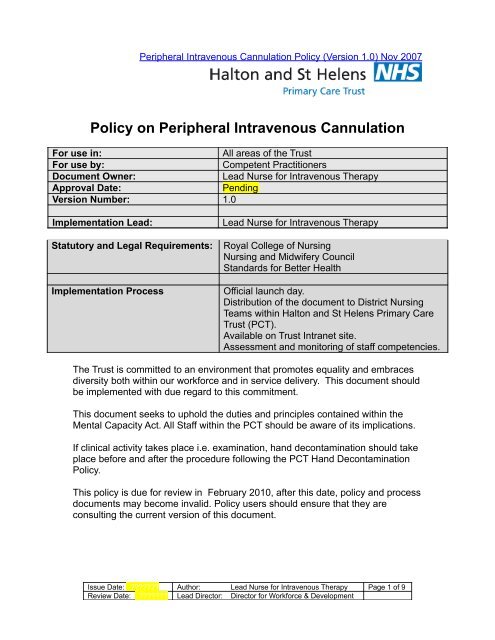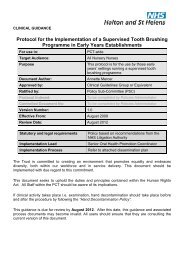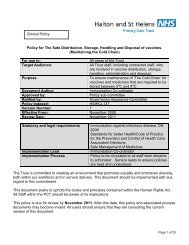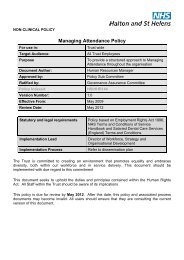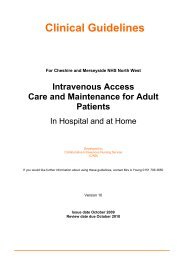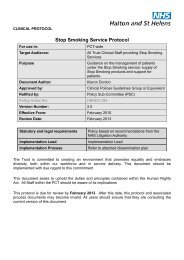Policy on Peripheral Intravenous Cannulation - Halton and St ...
Policy on Peripheral Intravenous Cannulation - Halton and St ...
Policy on Peripheral Intravenous Cannulation - Halton and St ...
Create successful ePaper yourself
Turn your PDF publications into a flip-book with our unique Google optimized e-Paper software.
<strong>Peripheral</strong> <strong>Intravenous</strong> Cannulati<strong>on</strong> <str<strong>on</strong>g>Policy</str<strong>on</strong>g> (Versi<strong>on</strong> 1.0) Nov 2007<br />
<str<strong>on</strong>g>Policy</str<strong>on</strong>g> <strong>on</strong> <strong>Peripheral</strong> <strong>Intravenous</strong> Cannulati<strong>on</strong><br />
For use in:<br />
All areas of the Trust<br />
For use by:<br />
Competent Practiti<strong>on</strong>ers<br />
Document Owner:<br />
Lead Nurse for <strong>Intravenous</strong> Therapy<br />
Approval Date:<br />
Pending<br />
Versi<strong>on</strong> Number: 1.0<br />
Implementati<strong>on</strong> Lead:<br />
<strong>St</strong>atutory <strong>and</strong> Legal Requirements:<br />
Implementati<strong>on</strong> Process<br />
Lead Nurse for <strong>Intravenous</strong> Therapy<br />
Royal College of Nursing<br />
Nursing <strong>and</strong> Midwifery Council<br />
<strong>St</strong><strong>and</strong>ards for Better Health<br />
Official launch day.<br />
Distributi<strong>on</strong> of the document to District Nursing<br />
Teams within Halt<strong>on</strong> <strong>and</strong> <strong>St</strong> Helens Primary Care<br />
Trust (PCT).<br />
Available <strong>on</strong> Trust Intranet site.<br />
Assessment <strong>and</strong> m<strong>on</strong>itoring of staff competencies.<br />
The Trust is committed to an envir<strong>on</strong>ment that promotes equality <strong>and</strong> embraces<br />
diversity both within our workforce <strong>and</strong> in service delivery. This document should<br />
be implemented with due regard to this commitment.<br />
This document seeks to uphold the duties <strong>and</strong> principles c<strong>on</strong>tained within the<br />
Mental Capacity Act. All <strong>St</strong>aff within the PCT should be aware of its implicati<strong>on</strong>s.<br />
If clinical activity takes place i.e. examinati<strong>on</strong>, h<strong>and</strong> dec<strong>on</strong>taminati<strong>on</strong> should take<br />
place before <strong>and</strong> after the procedure following the PCT H<strong>and</strong> Dec<strong>on</strong>taminati<strong>on</strong><br />
<str<strong>on</strong>g>Policy</str<strong>on</strong>g>.<br />
This policy is due for review in February 2010, after this date, policy <strong>and</strong> process<br />
documents may become invalid. <str<strong>on</strong>g>Policy</str<strong>on</strong>g> users should ensure that they are<br />
c<strong>on</strong>sulting the current versi<strong>on</strong> of this document.<br />
Issue Date: ??????? Author: Lead Nurse for <strong>Intravenous</strong> Therapy Page 1 of 9<br />
Review Date: ??????? Lead Director: Director for Workforce & Development
<str<strong>on</strong>g>Policy</str<strong>on</strong>g> C<strong>on</strong>tent<br />
1. Introducti<strong>on</strong><br />
The majority of patients who are accepted by the Home Outpatient Parenteral<br />
Therapy (HOPT) Service will have a suitable access device in situ. However, in<br />
certain circumstances that are listed below, some nurses will need to be able to<br />
perform peripheral intravenous cannulati<strong>on</strong>.<br />
• Patients who are receiving single dose infusi<strong>on</strong>s such as ir<strong>on</strong> sucrose,<br />
Herceptin etc.<br />
• Some patients are discharged from hospital <strong>and</strong> may <strong>on</strong>ly require a few<br />
days of intravenous therapy, therefore a peripheral cannula would be most<br />
appropriate device.<br />
• Patients who have been discharged from other acute Trusts may be<br />
discharged with peripheral devices that could be used in the short term<br />
until a more appropriate device can be placed.<br />
2. <str<strong>on</strong>g>Policy</str<strong>on</strong>g> <strong>St</strong>atus<br />
This is a clinical policy document<br />
3. Purpose<br />
This <str<strong>on</strong>g>Policy</str<strong>on</strong>g> is designed to give informati<strong>on</strong> about peripheral intravenous<br />
cannulati<strong>on</strong> to any practiti<strong>on</strong>er who has undertaken the appropriate training <strong>and</strong><br />
has been assessed as competent by either the HOPT Service or a delegated<br />
assessor. It is to be used in c<strong>on</strong>juncti<strong>on</strong> with Halt<strong>on</strong> & <strong>St</strong> Helens PCT’s Clinical<br />
Guidance for the Inserti<strong>on</strong>/Removal of <strong>Peripheral</strong> <strong>Intravenous</strong> Cannulae.<br />
4. Scope<br />
It applies to all practiti<strong>on</strong>ers who have undertaken a recognised training course<br />
which c<strong>on</strong>sists of a theoretical <strong>and</strong> practical comp<strong>on</strong>ent <strong>and</strong> have been assessed<br />
as competent, by the HOPT Service or a delegated assessor, following five<br />
successful inserti<strong>on</strong>s of peripheral intravenous cannulae.<br />
5. General <str<strong>on</strong>g>Policy</str<strong>on</strong>g> <strong>St</strong>atement<br />
Halt<strong>on</strong> & <strong>St</strong> Helens PCT will ensure that patients receive a high st<strong>and</strong>ard of care<br />
within the community setting whilst receiving therapy via a peripheral cannula.<br />
Clinicians will achieve this by:<br />
• <strong>St</strong>aff adhering to the policy <strong>and</strong> guidelines<br />
• Maintaining their own professi<strong>on</strong>al development<br />
• Working within the NMC code of c<strong>on</strong>duct<br />
Issue Date: ??????? Author: Lead Nurse for <strong>Intravenous</strong> Therapy Page 2 of 9<br />
Review Date: ??????? Lead Director: Director for Workforce & Development
6. Definiti<strong>on</strong>s<br />
Definiti<strong>on</strong>s of terms used in the document:<br />
<strong>Peripheral</strong> <strong>Intravenous</strong> - a procedure whereby a device is placed into a<br />
Cannulati<strong>on</strong><br />
patient’s vein to provide the therapeutic<br />
administrati<strong>on</strong> of drugs, fluid <strong>and</strong>/or blood<br />
products.<br />
Herceptin - medicati<strong>on</strong> used to treat patients with breast<br />
cancer.<br />
Ir<strong>on</strong> Sucrose - medicati<strong>on</strong> used to treat patients with ir<strong>on</strong><br />
deficiency anaemia.<br />
7. Duties <strong>and</strong> Resp<strong>on</strong>sibilities<br />
Legal <strong>and</strong> statutory duties <strong>and</strong> resp<strong>on</strong>sibilities to the following general (<strong>St</strong>atutory)<br />
duties apply:-<br />
The following guidance was used in the producti<strong>on</strong> of this document<br />
• Nursing <strong>and</strong> Midwifery Council (2004) Code of Professi<strong>on</strong>al C<strong>on</strong>duct<br />
• Royal College of Nursing (2005) <strong>St</strong><strong>and</strong>ards for infusi<strong>on</strong> therapy.<br />
The following specific duties <strong>and</strong> resp<strong>on</strong>sibilities within Halt<strong>on</strong> & <strong>St</strong> Helens PCT<br />
apply:<br />
The HOPT Service<br />
The HOPT Service are resp<strong>on</strong>sible for the delivery of training <strong>and</strong> educati<strong>on</strong><br />
sessi<strong>on</strong>s around <strong>Peripheral</strong> <strong>Intravenous</strong> Cannulati<strong>on</strong>. They are resp<strong>on</strong>sible for<br />
the assessment of practice of Community Nurses who have completed the<br />
theoretical comp<strong>on</strong>ent of the course <strong>and</strong> for the assessment of any other<br />
nominated assessors.<br />
Chief Executive:<br />
The Chief Executive has overall accountability for the implementati<strong>on</strong> <strong>and</strong><br />
adherence to the policy.<br />
Trust Board:<br />
The Trust Board is resp<strong>on</strong>sible for signing off the policy <strong>and</strong> has resp<strong>on</strong>sibility of<br />
all clinical care within the PCT.<br />
Director of Service Provisi<strong>on</strong>:<br />
Is resp<strong>on</strong>sible for ensuring the policy is implemented <strong>and</strong> adhered to.<br />
Halt<strong>on</strong> & <strong>St</strong> Helens PCT <strong>St</strong>aff:<br />
Have the resp<strong>on</strong>sibility for co-operating with the development <strong>and</strong><br />
implementati<strong>on</strong> of Corporate <strong>and</strong> Directorate policies <strong>and</strong> procedures as part of<br />
their normal duties <strong>and</strong> resp<strong>on</strong>sibilities.<br />
Issue Date: ??????? Author: Lead Nurse for <strong>Intravenous</strong> Therapy Page 3 of 9<br />
Review Date: ??????? Lead Director: Director for Workforce & Development
Temporary <strong>and</strong> Agency <strong>St</strong>aff, C<strong>on</strong>tractors <strong>and</strong> Subc<strong>on</strong>tractors:<br />
All temporary <strong>and</strong> Agency staff, C<strong>on</strong>tractors <strong>and</strong> Subc<strong>on</strong>tractors will be expected<br />
to comply with the requirements of Trust policies <strong>and</strong> procedures applicable to<br />
their area of operati<strong>on</strong>s.<br />
8. Process<br />
Please refer to Halt<strong>on</strong> <strong>and</strong> <strong>St</strong> Helens PCT’s Clinical Guidance for the<br />
Inserti<strong>on</strong>/Removal of <strong>Peripheral</strong> <strong>Intravenous</strong> Cannulae.<br />
9. Training Requirements<br />
Only nurses who have:<br />
• Undertaken a recognised training course, which c<strong>on</strong>sists of a theoretical<br />
<strong>and</strong> practical comp<strong>on</strong>ent<br />
• Been assessed as competent by the HOPT Service or a delegated<br />
assessor <strong>and</strong> completed the necessary number of successful inserti<strong>on</strong>s<br />
of peripheral intravenous cannulae<br />
are deemed as suitable to undertake this procedure within the PCT.<br />
Nurses who have come from other Trusts <strong>and</strong> can prove that they have<br />
completed similar training will need to be assessed at least <strong>on</strong>ce by a member of<br />
the HOPT Service or a delegated assessor to ensure that they comply with PCT<br />
guidelines.<br />
10.Implementati<strong>on</strong> M<strong>on</strong>itoring <strong>and</strong> Review<br />
The Lead Nurse for IV Therapy is resp<strong>on</strong>sible for implementing this <str<strong>on</strong>g>Policy</str<strong>on</strong>g><br />
The Lead Nurse for IV Therapy is resp<strong>on</strong>sible for ensuring that this document is<br />
reviewed <strong>and</strong>, if necessary, revised in the light of legislative, guidance or<br />
organizati<strong>on</strong>al change.<br />
Review shall be at intervals of no greater than 24 m<strong>on</strong>ths.<br />
Any revisi<strong>on</strong>s to this document shall be agreed through the approval process<br />
indicated <strong>on</strong> the title page.<br />
11. Documentati<strong>on</strong><br />
This document should be read in c<strong>on</strong>juncti<strong>on</strong> with:<br />
• RCN <strong>St</strong><strong>and</strong>ards for Infusi<strong>on</strong> Therapy (Nov. 2005)<br />
• Halt<strong>on</strong> & <strong>St</strong> Helens PCT Clinical Guidelines for the Inserti<strong>on</strong>/Removal of<br />
<strong>Peripheral</strong> <strong>Intravenous</strong> Cannulae.<br />
12.AUDIT<br />
Issue Date: ??????? Author: Lead Nurse for <strong>Intravenous</strong> Therapy Page 4 of 9<br />
Review Date: ??????? Lead Director: Director for Workforce & Development
This policy will be audited in line with the document Clinical Guidance for the<br />
Inserti<strong>on</strong>/Removal of <strong>Peripheral</strong> <strong>Intravenous</strong> Cannulati<strong>on</strong>.<br />
References<br />
Nursing <strong>and</strong> Midwifery Council (2004) Code of Professi<strong>on</strong>al C<strong>on</strong>duct<br />
Royal College of Nursing (2005) <strong>St</strong><strong>and</strong>ards for Infusi<strong>on</strong> therapy<br />
13. List of Appendices:<br />
Appendix 1 - Visual Infusi<strong>on</strong> Phlebitis Scale (Jacks<strong>on</strong>,1998).<br />
Appendix 2 - Infiltrati<strong>on</strong> Scale (<strong>Intravenous</strong> Nursing Society, 2000).<br />
Appendix 3 - Size <strong>and</strong> Manufacturers’ Recommended Use of <strong>Peripheral</strong><br />
<strong>Intravenous</strong> Cannula<br />
Issue Date: ??????? Author: Lead Nurse for <strong>Intravenous</strong> Therapy Page 5 of 9<br />
Review Date: ??????? Lead Director: Director for Workforce & Development
Issue Date: ??????? Author: Lead Nurse for <strong>Intravenous</strong> Therapy Page 6 of 9<br />
Review Date: ??????? Lead Director: Director for Workforce & Development
APPENDIX 1: PHLEBITIS SCALE (Jacks<strong>on</strong>, 1998)<br />
All patients with an intravenous access device in place must have the IV site checked at<br />
least daily for signs of infusi<strong>on</strong> phlebitis. The subsequent score <strong>and</strong> acti<strong>on</strong>(s) taken (if<br />
any) must be documented.<br />
The cannula site must also be observed:<br />
• When bolus injecti<strong>on</strong>s are administered.<br />
• IV flow rates are checked or altered.<br />
• When soluti<strong>on</strong> c<strong>on</strong>tainers are changed.<br />
The incidence of infusi<strong>on</strong> phlebitis varies; the following Good Practice Points may assist<br />
in reducing the incidence of infusi<strong>on</strong> phlebitis:<br />
• Observe cannula site at least daily.<br />
• Secure cannula with proven intravenous dressing.<br />
• Replace loose, c<strong>on</strong>taminated dressings.<br />
• Cannula must be inserted away from joints whenever possible.<br />
• Aseptic technique must be followed.<br />
• C<strong>on</strong>sider re-siting the cannula every 48-72 hours.<br />
• Plan <strong>and</strong> document c<strong>on</strong>tinuing care.<br />
• Use smallest possible gauge cannula most suitable for the patients need.<br />
• Replace the cannula at first indicati<strong>on</strong> of infusi<strong>on</strong> phlebitis (stage 2 <strong>on</strong> the scale<br />
below).<br />
<strong>St</strong>age<br />
IV site appears healthy.<br />
0<br />
No signs of phlebitis.<br />
ONE of the following is evident:<br />
• Slight pain near IV site.<br />
• Slight redness near IV site.<br />
TWO of the following are evident.<br />
• Pain at IV site.<br />
• Erythema.<br />
• Swelling.<br />
ALL the following signs are evident.<br />
• Pain al<strong>on</strong>g path of cannula.<br />
• Erythema.<br />
• Indurati<strong>on</strong>.<br />
ALL of the following signs are evident <strong>and</strong> extensive.<br />
• Pain al<strong>on</strong>g path of cannula.<br />
• Erythema.<br />
• Indurati<strong>on</strong>.<br />
• Palpable venous cord.<br />
ALL of the following signs are evident <strong>and</strong> extensive.<br />
• Pain al<strong>on</strong>g path of cannula.<br />
• Erythema.<br />
• Indurati<strong>on</strong>.<br />
• Palpable venous cord.<br />
1<br />
2<br />
3<br />
4<br />
OBSERVE CANNULA.<br />
Possibly first signs of<br />
phlebitis.<br />
OBSERVE CANNULA.<br />
Early stages of phlebitis.<br />
RESITE CANNULA.<br />
Medium stage of phlebitis.<br />
RESITE CANNULA<br />
CONSIDER TREATMENT.<br />
Advanced stages of phlebitis<br />
or the start of<br />
thrombophlebitis.<br />
RESITE CANNULA.<br />
CONSIDER TREATMENT.<br />
5 Advanced stage of<br />
thrombophlebitis.<br />
INITIATE TREATMENT.<br />
RESITE CANNULA<br />
Issue Date: ??????? Author: Lead Nurse for <strong>Intravenous</strong> Therapy Page 7 of 9<br />
Review Date: ??????? Lead Director: Director for Workforce & Development
• Pyrexia.<br />
APPENDIX 2: INFILTRATION SCALE (<strong>Intravenous</strong> Nursing Society, 2000)<br />
GRADE CLINICAL CRITERIA<br />
0 • No Clinical Symptoms.<br />
1 • Skin blanched.<br />
• Oedema. < 1 inch (2.5cm) in any directi<strong>on</strong>.<br />
• Cool to touch.<br />
• With or without pain.<br />
2 • Skin blanched.<br />
• Oedema. 1-6 inches. (2.5cm-15cm) in any directi<strong>on</strong>.<br />
• Cool to touch.<br />
• With or without pain.<br />
3 • Skin blanched, translucent.<br />
• Gross oedema > 6 inches (15cm) in any directi<strong>on</strong>.<br />
• Cool to touch.<br />
• Mild to moderate pain.<br />
• Possible numbness.<br />
4 • Skin blanched, translucent.<br />
• Skin tight, leaking.<br />
• Skin discoloured, bruised, swollen.<br />
• Gross oedema> 6inches (15cm) in any directi<strong>on</strong>.<br />
• Deep pitting tissue oedema.<br />
• Circulatory impairment.<br />
• Moderate to severe pain.<br />
• Infiltrati<strong>on</strong> of any amount of blood product, irritant, or<br />
vesicant.<br />
Issue Date: ??????? Author: Lead Nurse for <strong>Intravenous</strong> Therapy Page 8 of 9<br />
Review Date: ??????? Lead Director: Director for Workforce & Development
APPENDIX 3: SIZE AND MANUFACTURERS’ RECOMMENDED USE OF<br />
PERIPHERAL INTRAVENOUS CANNULA<br />
COLOUR SIZE USES<br />
Brown 14G Rapid transfusi<strong>on</strong>s of whole blood,<br />
resuscitati<strong>on</strong> settings<br />
Grey 16G Rapid transfusi<strong>on</strong> of whole blood<br />
or blood products<br />
White 17G Used for infusi<strong>on</strong> of large volumes<br />
of fluid or viscous fluid<br />
Green 18G Blood transfusi<strong>on</strong>s or large<br />
volumes of fluid<br />
Pink 20G Patients receiving up to 20 or 3<br />
litres of fluid a day, patients <strong>on</strong><br />
l<strong>on</strong>ger term medicati<strong>on</strong><br />
Blue 22G Paediatric <strong>and</strong> <strong>on</strong>cology patients<br />
Yellow 24G Paediatric <strong>and</strong> <strong>on</strong>e-off infusi<strong>on</strong>s<br />
Issue Date: ??????? Author: Lead Nurse for <strong>Intravenous</strong> Therapy Page 9 of 9<br />
Review Date: ??????? Lead Director: Director for Workforce & Development


